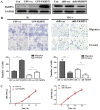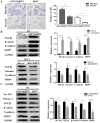FKBP51 promotes migration and invasion of papillary thyroid carcinoma through NF-κB-dependent epithelial-to-mesenchymal transition
- PMID: 30546435
- PMCID: PMC6256738
- DOI: 10.3892/ol.2018.9517
FKBP51 promotes migration and invasion of papillary thyroid carcinoma through NF-κB-dependent epithelial-to-mesenchymal transition
Abstract
FK506-binding protein 51 (FKBP51) is a member of the immunophilin family, with relevant roles in multiple signaling pathways, tumorigenesis and chemoresistance. However, the function of FKBP51 in papillary thyroid carcinoma (PTC) remains largely unknown. In the present study, increased FKBP51 expression was detected in PTC tissues as compared with adjacent normal tissues, and the expression level was associated with clinical tumor, node and metastasis stage. Using FKBP51-overexpressing K1 cells and FKBP51-knockdown TPC-1 cells, both human PTC cell lines, it was identified that FKBP51 promoted the migration and invasion of PTC, without affecting cell proliferation. Further investigation revealed that FKBP51 activated the NF-κB pathway and epithelial-to-mesenchymal transition (EMT) genes, and EMT was suppressed when NF-κB was inhibited. It was also assessed whether FKBP51 promoted the formation of cytoskeleton to promote migration and invasion of PTC using a tubulin tracker; however, no evidence of such an effect was observed. These results suggested that FKBP51 promotes migration and invasion through NF-κB-dependent EMT.
Keywords: epithelial-to-mesenchymal; invasion; migration.
Figures





Similar articles
-
The CXCL12-CXCR4 axis promotes migration, invasiveness, and EMT in human papillary thyroid carcinoma B-CPAP cells via NF-κB signaling.Biochem Cell Biol. 2018 Oct;96(5):619-626. doi: 10.1139/bcb-2017-0074. Epub 2018 Jan 9. Biochem Cell Biol. 2018. PMID: 29316404
-
BRAFV600E and RET/PTC Promote Proliferation and Migration of Papillary Thyroid Carcinoma Cells In Vitro by Regulating Nuclear Factor-κB.Med Sci Monit. 2017 Nov 8;23:5321-5329. doi: 10.12659/msm.904928. Med Sci Monit. 2017. PMID: 29117154 Free PMC article.
-
TFF3 Contributes to Epithelial-Mesenchymal Transition (EMT) in Papillary Thyroid Carcinoma Cells via the MAPK/ERK Signaling Pathway.J Cancer. 2018 Oct 31;9(23):4430-4439. doi: 10.7150/jca.24361. eCollection 2018. J Cancer. 2018. PMID: 30519349 Free PMC article.
-
Molecular Aspects of FKBP51 that Enable Melanoma Dissemination.Curr Mol Pharmacol. 2015;9(2):141-7. doi: 10.2174/1874467208666150519115242. Curr Mol Pharmacol. 2015. PMID: 25986563 Review.
-
Analysis of the Selective Antagonist SAFit2 as a Chemical Probe for the FK506-Binding Protein 51.ACS Pharmacol Transl Sci. 2023 Feb 14;6(3):361-371. doi: 10.1021/acsptsci.2c00234. eCollection 2023 Mar 10. ACS Pharmacol Transl Sci. 2023. PMID: 36926456 Free PMC article. Review.
Cited by
-
Molecular Chaperones in Cancer Stem Cells: Determinants of Stemness and Potential Targets for Antitumor Therapy.Cells. 2020 Apr 6;9(4):892. doi: 10.3390/cells9040892. Cells. 2020. PMID: 32268506 Free PMC article. Review.
-
With or without You: Co-Chaperones Mediate Health and Disease by Modifying Chaperone Function and Protein Triage.Cells. 2021 Nov 11;10(11):3121. doi: 10.3390/cells10113121. Cells. 2021. PMID: 34831344 Free PMC article. Review.
-
FKBP51 promotes invasion and migration by increasing the autophagic degradation of TIMP3 in clear cell renal cell carcinoma.Cell Death Dis. 2021 Oct 1;12(10):899. doi: 10.1038/s41419-021-04192-8. Cell Death Dis. 2021. PMID: 34599146 Free PMC article.
-
SLC34A2 Up-regulation And SLC4A4 Down-regulation Correlates With Invasion, Metastasis, And The MAPK Signaling Pathway In Papillary Thyroid Carcinomas.J Cancer. 2021 Jul 13;12(18):5439-5453. doi: 10.7150/jca.56730. eCollection 2021. J Cancer. 2021. PMID: 34405007 Free PMC article.
-
Androgen receptor signalling confers clonogenic and migratory advantages in urothelial cell carcinoma of the bladder.Mol Oncol. 2021 Jul;15(7):1882-1900. doi: 10.1002/1878-0261.12957. Epub 2021 May 22. Mol Oncol. 2021. PMID: 33797847 Free PMC article.
References
LinkOut - more resources
Full Text Sources
Miscellaneous
